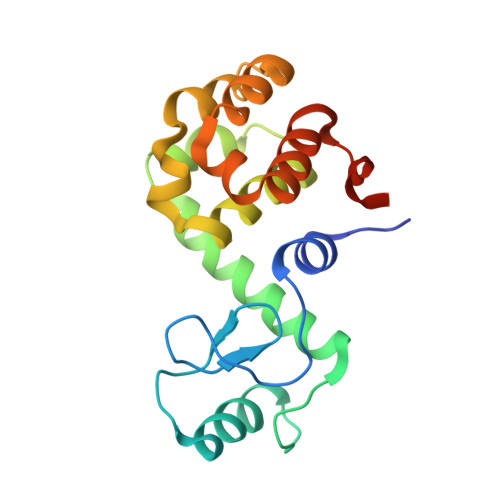Rationally designed protein cross-linked hydrogel for bone regeneration via synergistic release of magnesium and zinc ions.
Chen, X., Tan, B., Wang, S., Tang, R., Bao, Z., Chen, G., Chen, S., Tang, W., Wang, Z., Long, C., Lu, W.W., Yang, D., Bian, L., Peng, S.(2021) Biomaterials 274: 120895-120895
- PubMed: 34020269
- DOI: https://doi.org/10.1016/j.biomaterials.2021.120895
- Primary Citation of Related Structures:
7DWS - PubMed Abstract:
The development of recombinant protein cross-linked injectable hydrogels with good mechanical strength and effective drug loading capacity for bone regeneration is extremely attractive and rarely reported. Here, we report the fabrication of a smart hydrogel delivery system by incorporating a rationally designed T4 lysozyme mutant (T4M) to mediate the localized delivery and synergistic release of Mg 2+ and Zn 2+ for bone repair. Apart from its intrinsic antibacterial properties, T4M bears abundant free amine groups on its surface to function as effective covalent crosslinkers to strengthen the hydrogel network as well as exhibits specific binding affinity to multivalent cations such as Zn 2+ . Moreover, the integrin receptor-binding Arg-Gly-Asp (RGD) sequence was introduced onto the C-terminus of T4 lysozyme to improve its cellular affinity and further facilitate rapid tissue regeneration. The final composite hydrogel displays excellent injectability, improved mechanical properties, antibacterial activity, and unique bioactivities. The effective loading of Mg 2+ /Zn 2+ in the hydrogels could mediate the sequential and sustained release of Mg 2+ and Zn 2+ , thereby resulting in synergistic enhancement on bone regeneration through modulation of the MAPK signaling pathway. We believe that the strategy proposed in this paper opens up a new route for developing protein cross-linked smart delivery systems for tissue regeneration.
- Department of Spine Surgery and Institute for Orthopaedic Research, Shenzhen People's Hospital, The First Affiliated Hospital of Southern University of Science and Technology, Jinan University Second College of Medicine, Shenzhen Key Laboratory of Musculoskeletal Tissue Reconstruction and Function Restoration, Shenzhen, 518001, China.
Organizational Affiliation:

















